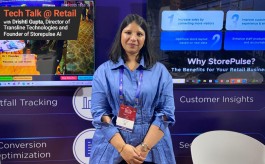Can sustainability become an integral part of the retail experience eco-system?
By N Jayalakshmi | June 05, 2025
Can the corporate motto of ‘people, planet & profits’ become a retail reality? Can environmental responsibility evolve into an integral part of the retail eco-system? On World Environmental Day, Retail4Growth begins the conversations with retail stakeholders to get some answers. In the first of these conversations, retail industry expert and retail experience design curator, Surender Gnanaolivu, shares his insights.

“The greatest threat to our planet is the belief that someone else will save it,” the words by Robert Swan that aptly convey the general human approach to environmental responsibility are quoted by Surender Gnanaolivu, retail industry expert/retail experience design curator & Independent Consultant at 4Dimensions Retail Design.
Reiterating the need to make environmental responsibility a talking point in the retail eco-system, Surender says, “There is enough data to suggest that consumers today prefer brands who are sensitive and empathetic to the world around.” He further adds, explaining the multidimensional aspects of sustainability in retail, “Today, there is a growing push from brands towards responsible practices in order to align with consumer expectations. In fact, today there are enough examples of retail brands across the world who implement sustainable practices, which can serve as case studies for others to jump-start this process. Secondly, governments across the worlds are realizing how the world is being adversely affected by rapid development and industrialization, so there is a move towards regulations that will make it environmentally-friendly practices mandatory across businesses. Finally, there are the manufacturers of retail solutions who are open to offering sustainable solutions, provided there is enough demand to justify it.”
Stakeholders’ alignment in the eco-system
Thus, as Surender points out, the eco-system is slowly gearing up and poised, especially with the growing synergy with global trends and as more and more brands integrate sustainable practices at the back-end in terms of manufacturing, supply chain, logistics, etc. But for it to become integral across the eco-system, and get embedded in the DNA would entail the active participation of all stakeholders, as Surender says.
When it comes to the store design fraternity, Surender feels the right approach would be to take a judicious approach that takes into account cost efficiency, while collaborating with solution providers and arrive at a sustainable store design solution. The key thus would be right partnerships that facilitate end to end sustainable practices. This means going beyond the exclusive focus on eco-friendly materials, that may not necessarily be cost efficient, and instead focusing on responsible practices such as recycling, reusing and re-purposing.
“There are many myths regarding sustainability and the common misconception is that being eco-friendly means using eco-friendly materials and hence the common perception of eco-friendly being expensive. But being eco-friendly is not limited to that. It’s primarily a mindset that is open to sustainable alternatives, whether in terms of materials or processes,” says Surender while driving home a critical point. He also mentions the role of technology in aiding sustainable practices and cites examples of how AI is being leveraged to suggest data backed sustainable options.
The question of mindset
The bottom line is: there are enough means to make sustainability a part and parcel of the retail experience eco-sytem. But what it needs is a mindset, one that makes it a mission and not merely a business mandate. The question is, will the VM and store design community, who play a crucial role in crafting the frond-end, consumer facing interface of a brand, drive this shift?









Comments